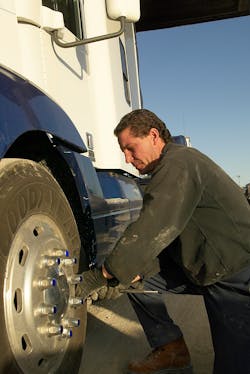Treading carefully: A guide to tire management
The key to optimal tire performance is not purely maintenance, says Evan Perrow, senior product marketing manager at Goodyear Tire & Rubber Company. Rather, it’s ensuring you have selected the right tires for your application.
Goodyear offers a variety of products, a nationwide network and fleet management tools to help commercial trucking fleets lower their total cost of ownership (goodyeartrucktires.com).
“Different trucks and operating conditions require different tires. Equipping trucks with the wrong tires can lead to sub-optimal performance,” Perrow says.
When selecting tires for your fleet, consider the applications the tires will be used for: over the road, localized applications, etc. Also consider specific operating conditions such as load carrying requirement, weather conditions or environmental issues. Then, work with a tire expert to select the best fit for your application, Perrow suggests.
The importance of tire pressure
Tire purchases are a significant financial investment, so good routine maintenance is essential for maximizing the life of your fleet’s tires.
“Maintaining proper inflation pressure in tires is the single most important factor in extending tire life,” says Gary Schroeder, director of truck and bus tire business for Cooper Tire & Rubber Company.
Cooper Tire & Rubber Company manufactures Roadmaster commercial tires, designed and engineered in the U.S. by an experienced technical team to provide performance, durability and retreadability (coopertire.com).
Both over- and underinflation have negative effects on the tire by changing its footprint, or the area contacting the road. Overinflation can make tires more vulnerable to cutting, punctures or damage, while underinflation causes excessive heat buildup and can cause internal structural damage, he says.
Further, when the tire is not contacting the road properly, the tread area will wear irregularly, and therefore more rapidly.
“A constant 20 percent underinflation in a commercial vehicle tire increases tread wear by 25 percent and reduces the tire lifetime by 30 percent,” adds Helmut Keller, head of brand management for commercial vehicle tires in the Americas at Continental. “Tire-related costs are the single largest maintenance expense item for commercial vehicle fleet operations, and improper tire inflation increases total tire-related costs by approximately $600 to $800 annually per tractor-trailer combination.”
Continental Tire in the Americas manufactures and distributes a complete line of passenger, light truck and commercial tires for OE and replacement markets (continental-truck.com).
A tire’s air pressure is important because the truckload weight can be quite high, and the air pressure in the tires has to support those loads. The number of tire-related issues can be reduced by maintaining proper tire pressure inspections.
Sharon Cowart, director of product marketing at Michelin Truck Tires, suggests maintaining all tires at a fleet’s target inflation pressure, which should be based on the manufacturer’s application data book for the particular axle load.
Michelin Truck Tires (michelintruck.com) designs, manufactures and sells tires for every type of vehicle, including airplanes, automobiles, farm equipment, heavy duty trucks and more.
An inflation pressure mismatch of greater than 5 psi, Cowart says, can result in the two tires of a dual assembly being significantly different in circumference, which will cause irregular wear and eventual tire loss. A difference of 5 psi between steer tires can cause the vehicle to pull to the side with the lower pressure.
“A difference in air pressure between two dual position tires is easy to fix, but frequently goes unnoticed until it causes visible tire wear,” adds Continental’s Keller. “Many drivers and maintenance personnel miss checking the tire inflation pressures on inside dual assemblies due to the difficulty of locating the air valve.”
Keller suggests that every tire on a vehicle should be checked at least weekly to ensure correct inflation and prevent damage that could lead to early tire removal.
Goodyear’s Perrow notes that it is also helpful to maintain a record of tire pressure checks and adjustments. Over time, that data can be used to help fleet managers make better decisions about their tire investments. He says there are tools to help fleet managers track this data.
Inspecting for tire wear
“Each trucking company and fleet has their own specifications for inspections,” says Aaron Murphy, vice president of commercial tire sales at TBC Corporation. “We recommend always reviewing [tire condition] at pre- and post-trip vehicle inspections. This allows for maintenance to manage the condition and reduce the downtime of the vehicle.”
TBC Corporation (tbccorp.com) is one of the largest vertically integrated marketers of tires for the U.S.’ automotive replacement market. TBC markets on a wholesale basis to regional tire chains and distributors throughout North America.
When inspecting tires, fleets should look for cracking or cuts in the sidewalls and uneven or excessive tread wear, which may be caused by improper inflation, misaligned wheels, mismatched tread depths or problems with suspension, says Brian Cunningham, vice president of sales at GCR Tires & Service.
GCR Tires & Service (GCRTires.com), a division of Bridgestone Americas, operates one of the largest commercial tire and service networks in North America, with more than 200 store locations and 1,500 service vehicles.
A routine pre-trip inspection and quick assessments on the road can improve tire performance and help diagnose any issues before they halt operations. Cunningham says these inspections help, but adds that “we can’t overstate the importance of having your tires regularly inspected by a tire professional.”
Companies like GCR offer standardized tire assessment programs with technicians trained specifically to evaluate tires on a regular basis.
He explains that a tire professional can interpret tire assessment data to make safety-focused preventative service recommendations, which can help customers avoid downtime and costly, unexpected repairs.
“Proper inflation pressure, correct toe settings and proper alignment can prevent most irregular wear,” Michelin’s Cowart adds. If irregular wear is detected, it is important to diagnose the underlying cause - it may reveal a gap in a fleet’s maintenance schedule, or it might indicate that the tire is not suited to the application. Cowart suggests talking to the tire dealer or manufacturer to determine the root cause of wear. Irregular wear can result in loss of tread life and a higher cost of total ownership.
Once a wear pattern is detected, the tire should be rotated or removed to be retreaded or scrapped. Otherwise, the wear pattern will continue, shortening the overall life of the tire. TBC’s Murphy says that the action a fleet manager should take depends on the wheel position and the severity of the wear.
“Removal many times is the best option to save the integrity of the casing for retreading and to not lose an asset prematurely,” he says.
When to replace
Murphy says that tire replacement frequency depends on the vehicle and how it is used.
“Adhering to DOT minimums is a good rule, but most fleets replace tires prior to those minimums to ensure casing integrity,” he says.
Cooper’s Schroeder adds that the DOT regulations say the tread depth for any tire on the front wheels of a bus, truck or truck tractor must be at least 4/32nds when measured at any point on a major tread groove. All other tires on the vehicle must have a tread depth of at least 2/32nds. If any measurements are below these requirements, he says, the tire should be removed.
“Some fleets will pull steer and drive position tires early to help maintain traction and rotate them back to the trailer to run out the remaining tread life,” Schroeder says. “If the fleet’s application tends to experience penetrations from nails or other road debris, then it’s probably a better practice to pull the tires early and retread them to help preserve the casing integrity.”
Schroeder notes that Roadmaster recommends that tires beyond 10 years from their date of manufacture be replaced with new tires, even if the tires appear undamaged and have not reached their tread wear limits. If a vehicle manufacturer recommends tire replacement after a certain interval, users should follow those specific recommendations.
Michelin’s Cowart adds that fleets should have a written maintenance policy to specify the maintenance practices they want followed. This policy should consider their vehicles, equipment, geography, distance traveled, loads carried and time on the road. It should also cover the specifics of new replacement tires entering the fleet and note a retreading policy.
The replacement policy should also cover the casings, number of times the casing will be retreaded based on vehicle usage, the casing age and condition, tire position and the type and quality of the new retreads.
Be proactive with maintenance
When it comes to a vehicle’s tires, proactive tire maintenance is important for avoiding unplanned downtime and premature wear. Taking steps such as driver inspection prior to each trip, maintaining proper tire pressure, monitoring tread depths, watching for irregular wear patterns and regularly inspecting suspension components can help ensure that fleets maximize their tire investment.
About the Author
Stefanie Von Rueden
Assistant Editor - Vehicle Repair Group
Stefanie Von Rueden is assistant editor for the Vehicle Repair Group.
Von Rueden’s background includes professional writing and publishing. Previously, she worked in the Continuing Education department at UW-Whitewater. She has covered the vehicle maintenance and automotive aftermarket since 2016.

